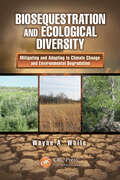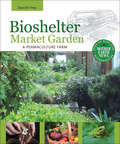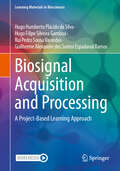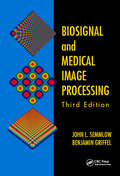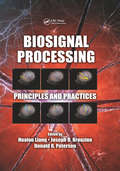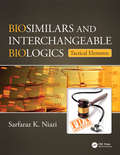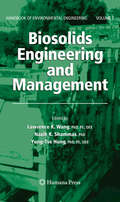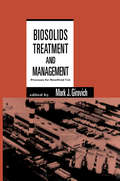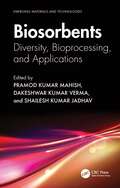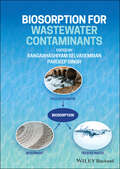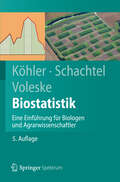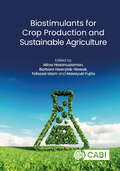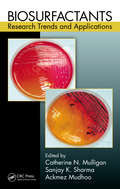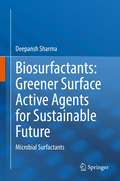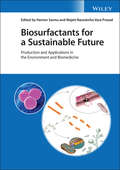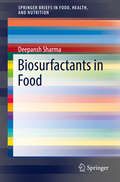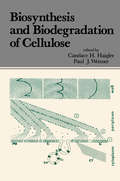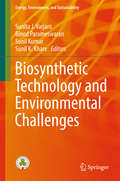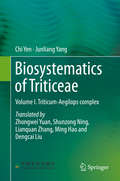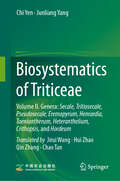- Table View
- List View
Biosequestration and Ecological Diversity: Mitigating and Adapting to Climate Change and Environmental Degradation (Social Environmental Sustainability)
by Wayne A. WhiteIncreased throughput of carbon-based fossil energy, the destruction of Earth's forests, and other land use changes have resulted in ever higher levels of waste in the form of greenhouse gases-as well as a diminished capacity of the planet to absorb and store those wastes. This means that to avoid catastrophic global warming and maintain the habitab
Bioshelter Market Garden: A Permaculture Farm (Mother Earth News Books for Wiser Living)
by Darrell Frey&“This well-illustrated case study . . . will help students of permaculture, of sustainability, of earth regeneration and of integrated eco-social design.&” —Prof. Declan Kennedy, Chairman, Advisory Board, gaiauniversity.org To ensure food security and restore the health of the planet, we need to move beyond industrial agriculture and return to the practice of small-scale, local farming. The Bioshelter Market Garden: A Permaculture Farm describes the creation of a sustainable food system through a detailed case study of the successful year-round organic market garden and permaculture design at Pennsylvania&’s Three Sisters Farm. At the heart of Three Sisters is its bioshelter—a solar greenhouse which integrates growing facilities, poultry housing, a potting room, storage, kitchen facilities, compost bins, a reference library and classroom area. The Bioshelter Market Garden examines how the bioshelter promotes greater biodiversity and is an energy efficient method of extending crop production through Pennsylvania&’s cold winter months. Both visionary and practical, this fully illustrated book contains a wealth of information on the application of permaculture principles. Some of the topics covered include: Design and management of an intensive market garden farmEnergy systems and bio-thermal resourcesEcological soil management and pest controlWetlands usageSolar greenhouse design and management Whatever your gardening experience and ambitions, this comprehensive manual is sure to inform and inspire.&“Darrell Frey&’s inspirational book gives you all you need to know to create an energy-saving, food-producing bioshelter . . . [It] covers everything you need to understand, build, or simply admire these important tools for sustainability.&” —Toby Hemenway, author of Gaia&’s Garden
Biosignal Acquisition and Processing: A Project-Based Learning Approach (Learning Materials in Biosciences)
by Hugo Humberto da Silva Hugo Filipe Silveira Gamboa Rui Pedro Sousa Varandas Guilherme Alexandre dos Santos Espadanal RamosThis textbook provides an introduction to common concepts in biosignal acquisition and processing, rooted in a Project-Based Learning (PBL). A series of exercises and corresponding solutions is described, with a focus on common problems that new entrants encounter in the undergraduate and graduate curriculums in biomedical engineering, psychophysiology, human-computer interaction, physiotherapy, and others developing work in the boundary between biosignal acquisition and other disciplines. Solutions include both hardware and software components, encompassing sensor design, biosignals acquisition using the Arduino and BITalino platforms, Python for signal processing, analysis, and knowledge extraction, including also HTML/CSS/JavaScript for user interface design. All the content is supported with rich graphics, source code, and other useful resources made available to the interested reader. This is an ideal book for undergraduate students and practitioners (across disciplines) who are studying or working in the field of biomedical signal acquisition, processing, and analysis.
Biosignal and Medical Image Processing
by John L. Semmlow Benjamin GriffelWritten specifically for biomedical engineers, Biosignal and Medical Image Processing, Third Edition provides a complete set of signal and image processing tools, including diagnostic decision-making tools, and classification methods. Thoroughly revised and updated, it supplies important new material on nonlinear methods for describing and classify
Biosignal Processing: Principles and Practices
by Hualou Liang Joseph D. Bronzino Donald R. PetersonWith the rise of advanced computerized data collection systems, monitoring devices, and instrumentation technologies, large and complex datasets accrue as an inevitable part of biomedical enterprise. The availability of these massive amounts of data offers unprecedented opportunities to advance our understanding of underlying biological and physiol
Biosimilars and Interchangeable Biologics: Tactical Elements
by Sarfaraz K. NiaziWhat's the Deal with Biosimilars?Biosimilars are gaining momentum as new protein therapeutic candidates that can help fill a vital need in the healthcare industry. The biological drugs are produced by recombinant DNA technology that allows for large-scale production and an overall reduction time in costs and development. Part of a two-volume set th
Biosolids Engineering and Management (Handbook of Environmental Engineering #7)
by Lawrence K. Wang Yung-Tse Hung Nazih K. ShammasThis is a collection of methods of practical design, calculation and numerical examples that illustrate how organized, analytical reasoning can lead to the discovery of clear, direct solutions to pollution especially in the areas of biosolids management, treatment, disposal and beneficial use. The book contains an extensive collection of detailed design examples and case histories, and a distinguished panel of authors provides insight into a range of topics.
Biosolids Treatment and Management: Processes for Beneficial Use (Environmental Science & Pollution)
by Mark J. GirovichThis work details the economic, regulatory and environmental protection issues related to biosolids management and use. It evaluates current treatment technologies and management strategies for the beneficial utilization of municipal wastewater residuals. Cost information regarding the relative economic merits of special reuse and disposal methods,
Biosonar (Springer Handbook of Auditory Research #51)
by Arthur N. Popper Richard R. Fay Annemarie Surlykke Paul E. NachtigallTwo groups of animals, bats and odontocetes (toothed whales), have independently developed the ability to orient and detect prey by biosonar (echolocation). This active mechanism of orientation allows these animals to operate under low light conditions. Biosonar is a conceptual overview of what is known about biosonar in bats and odontocetes. Chapters are written by bat and odontocetes experts, resulting in collaborations that not only examine data on both animals, but also compare and contrast mechanisms. This book provides a unique insight that will help improve our understanding of biosonar in both animal groups.
Biosorbents: Diversity, Bioprocessing, and Applications (Emerging Materials and Technologies)
by Pramod Kumar Mahish Dakeshwar Kumar Verma Shailesh Kumar JadhavThis book focuses on the biologically derived adsorbent with numerous applications in wastewater treatment, metal recovery, biosensor development, and so forth. It initiates with the description of biological sources of biosorbents followed by applications of biosorbents, biosorption isotherms, assessment of biosorbents with various tools, pretreatment of biosorbents, and its mode of action. Some less explored areas like separation of radionuclides, biosorption of volatile organic compounds, and animal-based biosorbents are also explained.Features: Focuses on fundamentals, characteristics of flora and fauna-mediated biosorbents used extensively Describes entire aspects of tools and techniques related to assessment and monitoring of biosorbents Includes adsorption kinetics, adsorption isotherm, and mechanism of action of biosorbents Covers advancements in pretreatment methods to enhance the adsorption process of biosorbents Reviews recent applications which include heavy metal removal, dye remediation, and separation of radionuclides and nano-biosorbents This book is aimed at graduate students and researchers in bioprocess engineering, microbiology, and biotechnology.
Biosorption for Wastewater Contaminants
by Rangabhashiyam Selvasembian Pardeep SinghPollution due to various anthropogenic activities continues to increase. In terms of water pollutants, organic and inorganic pollutants are the most problematic. Although several measures have been proposed and implemented to prevent or reduce contamination, their increased concentration in water bodies has created serious concerns. Over the years, the problem has been aggravated by industrialization, urbanization and the exploitation of natural resources. The direct discharge of wastewater contaminants and their geographical mobilization have caused an increase in concentration in ground, surface, fluvial and residual waters. Extensive information about detection and disposal methods is needed in order to develop technological solutions for a variety of environments, both urban and rural. This book provides up-to-date information on wastewater contaminants, aimed at researchers, engineers and technologists working in this field. Conventional physicochemical techniques used to remove contaminants from wastewater include ion exchange, precipitation, degradation, coagulation, coating, membrane processes and adsorption. However, these applications have technological and economic limitations, and involve the release of large amounts of chemical reagents and by-products that are themselves difficult to remove. Biosorption - the use of organically generated material as an adsorbent – is attracting new research and scholarship. Thermally-treated calcined biomaterials may be treated to remove heavy metals from wastewater. To ensure the elimination of these contaminants, existing solutions must be integrated with intelligent biosorption functions. Biosorption for Wastewater Contaminants will find an appreciative audience among academics and postgraduates working in the fields of environmental biotechnology, environmental engineering, wastewater treatment technology and environmental chemistry.
Biostatistics for Animal Science, 3rd Edition
by Miroslav Kaps William R. LambersonDesigned to cover techniques for analysis of data in the animal sciences, this popular textbook provides an overview of the basic principles of statistics enabling the subsequent applications to be carried out with familiarity and understanding. Each chapter begins by introducing a problem with practical questions, followed by a brief theoretical background. Most topics are followed up with numerical examples to illustrate the methods described using data-sets from animal sciences and related fields. The same examples are then solved using the SAS software package. Key features of this third edition: - Updated throughout, and covers a wealth of new distributions and new material on non-normal dependent variables - Improved clarity of text and examples - Includes both basic techniques and more complex procedures to provide an essential resource whatever your level - Contains exercises and many worked examples in SAS. Written primarily for students and researchers in animal sciences, the text is also useful for those studying agricultural, biological, and veterinary sciences.
Biostatistik: Eine Einführung für Biologen und Agrarwissenschaftler (Springer-Lehrbuch)
by Gabriel Schachtel Peter Voleske Wolfgang KöhlerDie Auswertung experimenteller Ergebnisse ist für Biologen und Agrarwissenschaftler ein wichtiges Handwerkszeug. Mit dieser gut verständlichen Einführung in Grundlagen und Anwendungen der Biometrie ist ein schneller Einstieg in die Statistik möglich. Soweit wie möglich wird ohne Formeln und mathematische Symbolik die hinter den Verfahren stehende Grundidee komplexer statistischer Verfahren erläutert. Die 5. Auflage enthält zusätzlich Schemata zur Versuchsplanung und Auswertung sowie ein erweitertes Glossar englischer Fachausdrücke.
Biostimulants: Exploring Sources and Applications (Plant Life and Environment Dynamics)
by Naleeni Ramawat Vijay BhardwajThis edited book is a comprehensive compilation highlighting sources of biostimulants, their production, influence on plant growth and development, and regulatory status of plant biostimulants for better understanding and opening new vistas for future research. Biostimulants, the biological formulations are known to meliorate the plants growth and vigour, improve nutritional efficiency along with maintaining their well-being mainly via providing protection against a wide range of infections. Both horticultural as well as agricultural crops involve the utilization of the biostimulants. Fulvic and humic acids, nitrogen-containing compounds, protein hydrolysates, favourable bacteria and fungi, and extracts of seaweed are the chief active components of these. The major driving force for these materials is the organic farming industry and demand for sustainable crop production. This book will be of great interest to researchers, teachers, climate change scientists, capacity builders, and policy makers. Moreover, this book does the work of a supplementary reading for students in various fields such as agriculture, soil science, ecology, environmental science and forestry at undergraduate as well as graduate level. This will be a gainful read for national and international agricultural scientists and the policy makers.• Elaborates on biostimulants induced influence of plant growth and development • Covers all aspects of biostimulants sources and its role in plant life in detail • Discusses evidence based approach in biostimulants sources and its useful applications in plants
Biostimulants for Crop Production and Sustainable Agriculture
by Mirza Hasanuzzaman Barbara Hawrylak-Nowak Tofazzal Islam Masayuki FujitaAgricultural biostimulants are a group of substances or microorganisms, based on natural resources, that are applied to plants or soils to improve nutrient uptake and plant growth, and provide better tolerance to various stresses. Their function is to stimulate the natural processes of plants, or to enrich the soil microbiome to improve plant growth, nutrition, abiotic and/or biotic stress tolerance, yield and quality of crop plants. Interest in plant biostimulants has been on the rise over the past 10 years, driven by the growing interest of researchers and farmers in environmentally-friendly tools for improved crop performance. Focusing on recent progress on biostimulants and their role in crop production and agricultural sustainability, this book includes: 31 chapters on a wide range of biostimulants and their role in plant growth stimulation and stress tolerance. Mechanism of actions of diverse groups of biostimulants, such as trace elements, plant and seaweed extracts, humic substances, polyamines, osmolytes, vitamins, nanoparticles and microorganisms. New promising biostimulants with novel modes of action. Improved crop production technologies are urgently needed to meet the growing demand for food for the ever-increasing global population by addressing the impacts of changing climate on agriculture. This book is of interest to researchers in agriculture, agronomy, crop and plant science, soil science and environmental science.
Biosurfaces
by Kantesh Balani Arvind Agarwal Roger Narayan Vivek VermaIdeal as a graduate textbook, this title is aimed at helpingdesign effective biomaterials, taking into account the complexinteractions that occur at the interface when a synthetic materialis inserted into a living system. Surface reactivity,biochemistry, substrates, cleaning, preparation, and coatingsare presented, with numerous case studies and applicationsthroughout. Highlights include:Starts with concepts and works up to real-life applicationssuch as implantable devices, medical devices, prosthetics, and drugdelivery technologyAddresses surface reactivity, requirements for surface coating,cleaning and preparation techniques, and characterizationDiscusses the biological response to coatingsAddresses biomaterial-tissue interactionIncorporates nanomechanical properties and processingstrategies
Biosurfactants: Research Trends and Applications
by Catherine N. Mulligan Sanjay K. Sharma Ackmez MudhooMicrobially derived surfactants, called biosurfactants, provide a promising alternative to synthetic surfactants, displaying better availability and being generally nontoxic and biodegradable. Biosurfactants also have the advantage of diverse chemical properties and the potential to be less expensive. They demonstrate properties such as reducing su
Biosurfactants: Microbial Surfactants
by Deepansh SharmaThis book illustrates the importance and significance of the biosurfactants obtained from microorganisms, preferably from bacteria and yeast. It explains the superiority of biosurfactants (green molecule) over chemically synthesized surfactants for the sustainable future. The content of the present book addresses the quest for novel biosurfactants producing strains, high throughput screening methods, and production strategies. It finely describes the aptness of biosurfactants for industrial and environmental applications. It elaborately describes the technical background and cutting-edge advancement of the commercial aspect of biosurfactants. In the later part of the book, the role of green biosurfactants in food processing, control of food spoilage, incorporation in personal health care products, environmental and agricultural remediation are discussed. Finally, the book elucidates a comprehensive and representative description of toxicity assessment of the biosurfactants, which highlights the risk assessment of the incorporation of the microbial biosurfactants in food, healthcare, and pharmaceutical formulations.
Biosurfactants for a Sustainable Future: Production and Applications in the Environment and Biomedicine
by Majeti Narasimha Vara Prasad Hemen SarmaExplore the state-of-the-art in biosurfactant technology and its applications in environmental remediation, biomedicine, and biotechnology Biosurfactants for a Sustainable Future explores recent developments in biosurfactants and their use in a variety of cutting-edge applications. The book opens a window on the rapid development of microbiology by explaining how microbes and their products are used in advanced medical technology and in the sustainable remediation of emerging environmental contaminants. The book emphasizes the different techniques that are used for the production of biosurfactants from microorganisms and their characterization. Various aspects of biosurfactants, including structural characteristics, developments, production, bio-economics and their sustainable use in the environment and biomedicine, are addressed, and the book also presents metagenomic strategies to facilitate the discovery of novel biosurfactants producing microorganisms. Readers will benefit from the inclusion of: A thorough introduction to the state-of-the-art in biosurfactant technology, techniques, and applications An exploration of biosurfactant enhanced remediation of sediments contaminated with organics and inorganics A discussion of perspectives for biomedical and biotechnological applications of biosurfactants A review of the antiviral, antimicrobial, and antibiofilm potential of biosurfactants against multi-drug-resistant pathogens. An examination of biosurfactant-inspired control of methicillin-resistant staphylococcus aureus Perfect for academic researchers and scientists working in the petrochemical industry, pharmaceutical industry, and in the agroindustry, Biosurfactants for a Sustainable Future will also earn a place in the libraries of scientists working in environmental biotechnology, environmental science, and biomedical engineering.
Biosurfactants in Food (SpringerBriefs in Food, Health, and Nutrition)
by Deepansh SharmaThe present work aims to cover the perspectives of biosurfactants, which can be of interest in food-related industries and biomedical applications. Biosurfactants are a structurally diverse group of surface-active molecules extensively produced by bacteria, yeast and fungi. Despite having significant potential associated with emulsion formation, anti-adhesive and antimicrobial activities, considerably few applications have been reported regarding applications of biosurfactants in food formulations and processing. The utilization of biosurfactants, which are highly functional in food and biomedical applications, has become more and more significant. Along with providing an overview of biosurfactant properties, the book suggests how these properties could be applicable in the food industry.
Biosynthesis and Biodegradation of Cellulose
by Candace H. HaiglerA gathering of articles bringing together knowledge of both the synthesis and degradation of a pervasive biological substance, cellulose. Topics include native cellulose; particle rosettes and terminal globules; microfibril biogenesis; synthesis in Acetobacter xylinum ; biodegradation measurement; e
Biosynthetic Technology and Environmental Challenges (Energy, Environment, and Sustainability)
by Sunil Kumar Sunita J. Varjani Binod Parameswaran Sunil K. KhareThis book provides a comprehensive review of biosynthetic approaches to the production of industrially important chemicals and the environmental challenges involved. Its 19 chapters discuss different aspects of biosynthetic technology from the perspective of leading experts in the field. It covers various biorefinery approaches, including the use of microbes, metabolically engineered plants, biomass-based and green technology methods. Further, it examines important research in the areas of organic and hazardous waste composting, management and recovery of nutraceuticals from agro-industrial waste, biosynthesis and technological advancements of biosurfactants and waste water bioremediation. This book contributes to the scientific literature on biosynthetic technologies and the related environmental challenges for researchers and academics working in this area around the globe.
Biosystematics of Triticeae: Volume I. Triticum-Aegilops complex
by Chi Yen Junliang YangThis book discusses the natural classification and biosystematics of Triticeae, and presents the most significant findings of comprehensive studies on the Triticeae, an important tribe in the grass family (Poaceae) that includes major crops such as wheat, barley, rye and triticale, as well as various forage crops found in different genera. The five-volume Chinese version of Biosystematics of Triticeae was published in 1998, 2004, 2006, 2011, and 2013, and included the 30 genera, 2 subgenera, 464 species, 9 subspecies, and 186 varieties of Triticeae identified to date. This completely revised English edition features up-to-date international research and the latest advances in the field. The book is divided into five volumes, covering a wide range of disciplines from traditional taxonomy and cytogenetics, to molecular phylogeny. Volume I, Triticum-Aegilops complex focuses on the taxonomy and generic relationships of Triticum and Aegilops, discussing the origin of common wheat as a crop. Volume II highlights the taxonomy and systematics of Secale, Tritiosecale, Pseudosecale, Eremopyrum, Henrardia, Taeniantherum, Heteranthelium, Crithopsis, and Hordeum.Volume III describes perennial genera and species including Kengyilia, Douglasdeweya, Agropyron, Australopyrum, and Anthosachne. Volume IV addresses perennial genera and species including Stenostachys, Psathyrostachys, Leymus, Pseudoroegneria, and Roegeneria. Volume V presents perennial genera and species such as Campeiostachys, Elymus,Pascopyrum, Lophopyrum, Trichopyrum, Hordelymus, Festucopsis, Peridictyon, and Psammopyrum.
Biosystematics of Triticeae: Volume V. Genera: Campeiostachys, Elymus,Pascopyrum, Lophopyrum, Trichopyrum, Hordelymus, Festucopsis, Peridictyon, and Psammopyrum
by Chi Yen Junliang YangThis book review and rearrange the research data of Triticeae published over hundreds of years, applying a modern scientific approach. Triticeae is an important tribe in the grass family (Peaceae). It includes the major cereal crops, such as wheat, barley and rye, in addition to many valuable forage crops found in different genera, such as Elymus, Agropyron, Pasthyrostachys, and Leymus. The knowledge of appropriate Triticeae taxonomy and biosystematics will serve as genetic breeding of wheat, barley, rye and forage grass. The authors attempted to remain the truth and remove the false for deriving a more natural biosystematics of Triticeae. This book covers taxonomy, cytogenetics, and molecular phylogeny. It summarizes the biosystematics of Triticeae with comprehensive and updated data. This book is divided into five volumes (Volumes 1- 5), and includes 30 genera, 2 subgenera, 464 species, 9 subspecies, and 186 varieties in Triticeae. Volume 5 introduces nine perennial genera in Triticeae: Campeiostachys, Elymus, Pascopyrum, Lophopyrum, Trichopyrum, Hordelymus, Festucopsis, Peridictyon, and Psammopyrum. Elymus (StH), Campeiostachys (StYH), Lophopyrum (E), and Trichopyrum (ESt)are polymorphic genus. They show similar morphological characters, and it is difficult to distinguish them based merely on morphological variation. Pascopyrum (StHNsXm), Hordelymus (XoXr), Festucopsis (L), Peridictyon (Xp), and Psammopyrum (EL) are small genera, mostly monotypic genera. This book can serve as highly qualified, valuable, and convenient handbooks for audiences who are interested in Triticeae. This book also includes many illustrations, in addition to the description, to help the audience understand, morphological features of the concerned taxa, which makes the explanation more precise and obvious. It is a useful tool to understand the relationship among species in Triticeae.
Biosystematics of Triticeae: Volume II. Genera: Secale, Tritiosecale, Pseudosecale, Eremopyrum, Henrardia, Taeniantherum, Heteranthelium, Crithopsis, and Hordeum
by Chi Yen Junliang YangThis book discusses the natural classification and biosystematics of Triticeae and presents the most significant findings of comprehensive studies on the Triticeae, an important tribe in the grass family (Poaceae) that includes major crops such as wheat, barley, rye, and triticale, as well as various forage crops found in different genera. The five-volume Chinese version of Biosystematics of Triticeae was published in 1998, 2004, 2006, 2011, and 2013, and included the 30 genera, two subgenera, 464 species, nine subspecies, and 186 varieties of Triticeae identified to date. This is their English edition. The book is divided into five volumes, covering a wide range of disciplines from traditional taxonomy and cytogenetics to molecular phylogeny. Volume I, Triticum-Aegilops complex focuses on the taxonomy and generic relationships of Triticum and Aegilops, discussing the origin of common wheat as a crop. Volume II, Genera: Secale, Tritiosecale, Pseudosecale, Eremopyrum, Henrardia, Taeniantherum, Heteranthelium, Crithopsis, and Hordeum highlights a number of genera that are closely related based on their morphological classification and that contain only one unique genome. Volume III describes perennial genera and species including Kengyilia, Douglasdeweya, Agropyron, Australopyrum, and Anthosachne. Volume IV addresses perennial genera and species including Stenostachys, Psathyrostachys, Leymus, Pseudoroegneria, and Roegeneria. Volume V presents perennial genera and species such as Campeiostachys, Elymus, Pascopyrum, Lophopyrum, Trichopyrum, Hordelymus, Festucopsis, Peridictyon, and Psammopyrum.
